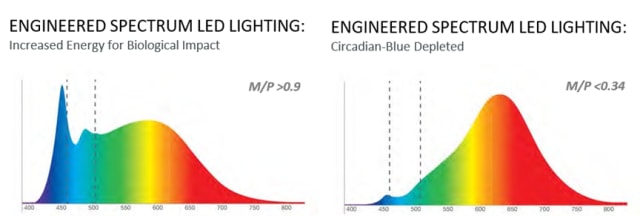Innovative LED lighting based on human biology helps keep the human circadian rhythm aligned, enhancing physical and psychological well-being.
LANTANA LED has sponsored this post.

The advent of artificial lighting forever changed the landscape of how humans live and work. While constant access to light created new opportunities for productivity, traditional lighting was crafted for seeing when it was dark outside and made it possible to work indoors. However, not considered was the effect of depriving us of natural light.
Lighting and human health has been one of the latest areas of focus for LANTANA LED.
With extensive knowledge and experience in circadian lighting, Dawn Pogue, Channel Manager at LANTANA LED explains, “We have consistently addressed indoor lighting challenges by identifying the issue at hand and strategizing solutions. LANTANA LED is prioritizing circadian lighting to address the growing need for human health and well-being in commercial spaces.”
In the realm of modern illumination, the quest for lighting solutions that mimic the benefits of natural light has led to the emergence of Biological LED lighting. This innovative approach not only seeks to replicate the positive effects of sunlight but also addresses the detrimental impacts of artificial lighting on human health and well-being.
Natural Light Versus Artificial Lighting
Humans need sunlight. Unfortunately, most people spend approximately 90% of their time indoors under artificial lights. Depending on the facility, some workers may not get any real light while on duty. Considering that burnout and exhaustion are on the rise, with one study noting that 52% of respondents frequently or always felt exhausted, the time has come to consider the true effects of natural and artificial light on humans and how human-centric lighting can assist in keeping employees healthier.
Sunlight varies throughout the day from morning sunlight infused with more blue light to evening with warmer amber hues that signal the brain to produce melatonin for sleep. Circadian entrainment is an approximately 24-hour cycle that humans need to reset and recharge. The process helps the body coordinate its vital functions, including cell regeneration.
Regardless of the type of sunlight, one study indicated that spending a median of 2.5 hours outdoors in the daylight can greatly affect one’s well-being, significantly reducing the potential for depressive disorders.
When a person’s circadian rhythm is aligned, it not only provides energy to get through the day but also enhances the quality of sleep. Even getting 30 minutes of direct sunlight daily has proven to help people sleep better at night. A good night’s rest goes hand in hand with enhanced productivity, another benefit of natural light. Absorbing the sun’s rays, especially during the day with blue light, increases alertness, focus and energy. Natural lighting helps create a pleasant working environment, which can also influence employee satisfaction.
Although science has proven the benefits of taking in natural light, the modern world does not always accommodate this basic human need. Constant exposure to inefficient lighting can lead to headaches, vision issues, depression and fatigue. Compounded over time, these conditions increase the chances of long-term illnesses, including diabetes, heart conditions and some cancers.
From too much to too little light, the amount and type of light create conditions that may make employees lose focus, work slower and decrease morale. That in turn increases the chances of higher turnover and absenteeism. Decreased focus also impacts the rates of workplace injuries and accidents.
Creating Human-Centric Light
The blending of human biology and lighting technology is now making it possible for public and private entities to install lighting that not only lets employees see better, but which also works to promote circadian rhythms. The latest circadian LED lighting mimics how light regulates the body, incorporating different colors and intensities that align with the natural light cycle.
While the rods and cones in the retina allow humans to see and provide color and details, scientists have uncovered the cells that absorb light and emit signals to the brain regarding light levels. Intrinsically photosensitive retinal ganglion cells (ipRGCs) have a receptor called melanopsin, which creates the non-visual responses to light needed for the circadian rhythm.
The ipRGCs in the retina communicate blue light levels to the suprachiasmatic nucleus (SCN), which is the human biological clock. This constant clock relies on taking in circadian blue between 460 to 490 nm during the daytime for energy.
The science behind lighting also revolves around color, intensity and illumination. The established color temperature scale (CTS) reflects the visual spectral output of LED lighting. As opposed to melanopsin, which triggers a biological response, CTS provides a psychological response. A CTS above 4,600 creates blue-white light that is cool and evokes a sense of energy while lower levels provide a non-temperature warmth that can impact melatonin production. Lighting designers use Correlated Color Temperature (CCT) to translate the Kelvin scale to CTS.
While traditional LED lighting provided a more efficient means of providing light, it still lacked qualities that align with the human body. The spectral power distribution (SPD) graph provides a way to determine the effect of light on humans, enabling the creation of more lighting colors and accurate output. This visual representation of a light source’s wavelengths also showed that there are gaps in the spectra.

“Color correlated temperature is not an indicator of the biological impact of a light,” Pogue said. “Careful selection of the semiconductor material, doping it with appropriate elements and optimizing the LED design to emit light in the blue wavelength range of 480 to 490 nanometers is required for circadian influence.”
Lighting professionals can tailor lighting solutions that not only enhance visual perception but also support the body’s biological responses to light using the Melanopic/Photopic (M/P) ratio, which compares how different light sources affect both visual and non-visual functions. A high M/P of more than 0.9 mimics the blue-filled sunlight of the morning while a M/P ratio under 0.4 provides depleted blue light that signals the body to start slowing down.

Another key measurement is the Equivalent Melanopic Lux (EML). EML is a more comprehensive measure of the light’s impact on human biology than traditional lux measurements. EML focuses on the melanopsin response rather than just melatonin suppression. The WELL Building Standard recommends aiming for 200 EML during daylight hours.
Circadian lighting stands at the forefront of revolutionizing indoor illumination by harmonizing our biological rhythms with the natural patterns of daylight. Its benefits extend across diverse industries, enhancing productivity in office settings by boosting alertness and reducing fatigue, improving patient outcomes in healthcare facilities through better sleep and mood regulation and fostering learning environments in educational institutions by optimizing focus and cognitive function. Embracing circadian lighting not only elevates the quality of illuminated spaces but also nurtures well-being and performance across a spectrum of professional domains.
Elevate your lighting experience and read more about circadian lighting at LANTANA LED here.



